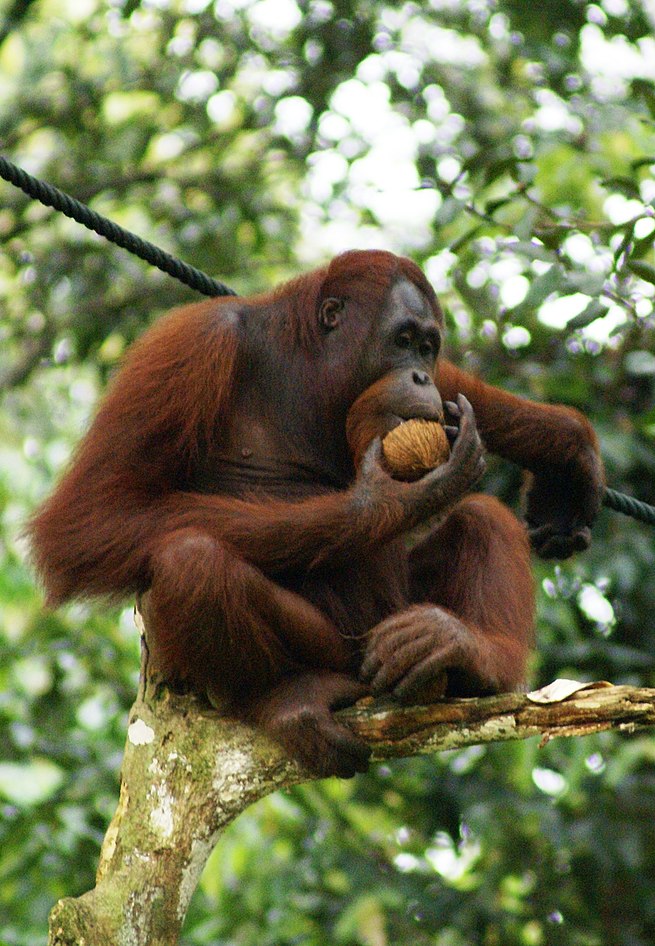-
Orangutan
The orangutans (also spelled orang-utan, orangutang, or orang-utang) are three extant species of great apes native to Indonesia and Malaysia. Orangutans are currently only found in the rainforests of Borneo and Sumatra. Classified in the genus Pongo, orangutans were originally considered to be one species. From 1996, they were divided into two species: the Bornean orangutan (P. pygmaeus, with three subspecies) and the Sumatran orangutan (P. abelii). In November 2017 it was reported that a third species had been identified, the Tapanuli orangutan (P. tapanuliensis).Genomic comparisons show that the Tapanuli orangutan separated from the Sumatran orangutan about 3.4 million years ago. The Tapanuli orangutan separated from the Bornean orangutan much later, about 670,000 years ago. The orangutans are the only surviving species of the subfamily Ponginae, which also included several other species, such as the three extinct species of the genus Gigantopithecus, including the largest known primate, Gigantopithecus blacki. The ancestors of the Ponginae split from the main ape line in Africa 16 to 19 million years ago (Mya) and spread into Asia.
Orangutans are the most arboreal of the great apes and spend most of their time in trees. Their hair is reddish-brown, instead of the brown or black hair typical of chimpanzees and gorillas. Males and females differ in size and appearance. Dominant adult males have distinctive cheek pads and produce long calls that attract females and intimidate rivals. Younger males do not have these characteristics and resemble adult females. Orangutans are the most solitary of the great apes, with social bonds occurring primarily between mothers and their dependent offspring, who stay together for the first two years. Fruit is the most important component of an orangutan’s diet; however, the apes will also eat vegetation, bark, honey, insects and even bird eggs. They can live over 30 years in both the wild and captivity.
Orangutans are among the most intelligent primates; they use a variety of sophisticated tools and construct elaborate sleeping nests each night from branches and foliage. The apes have been extensively studied for their learning abilities. There may even be distinctive cultures within populations. Field studies of the apes were pioneered by primatologist Birutė Galdikas. All three orangutan species are considered to be critically endangered. Human activities have caused severe declines in populations and ranges. Threats to wild orangutan populations include poaching, habitat destruction, and the illegal pet trade. Several conservation and rehabilitation organisations are dedicated to the survival of orangutans in the wild.
-
Gorilla
Gorillas are ground-dwelling, predominantly herbivorous apes that inhabit the forests of central Sub-Saharan Africa. The genus Gorilla is divided into two species: the eastern gorillas and the western gorillas (both critically endangered), and either four or five subspecies. They are the largest living primates. The DNA of gorillas is highly similar to that of humans, from 95–99% depending on what is counted, and they are the next closest living relatives to humans after the chimpanzees and bonobos.
Gorillas’ natural habitats cover tropical or subtropical forests in Sub-Saharan Africa. Although their range covers a small percentage of Sub-Saharan Africa, gorillas cover a wide range of elevations. The mountain gorilla inhabits the Albertine Rift montane cloud forests of the Virunga Volcanoes, ranging in altitude from 2,200–4,300 metres (7,200–14,100 ft). Lowland gorillas live in dense forests and lowland swamps and marshes as low as sea level, with western lowland gorillas living in Central West African countries and eastern lowland gorillas living in the Democratic Republic of the Congo near its border with Rwanda.
-
Orangutan (noun)
An arboreal anthropoid ape genus Pongo consisting of two species, Pongo pygmaeus of Borneo and Pongo abelii of Sumatra, having a shaggy reddish-brown coat, long arms, and no tail.
-
Gorilla (noun)
The largest of the apes, native to the forests of central Africa, and known for their trait of knuckle-walking
-
Gorilla (noun)
A big and brutish man or a thug; a goon or ruffian.

